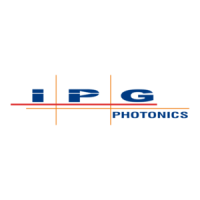
Do you have a question about the IPG Photonics LC 340.01-A.3.5/6 and is the answer not in the manual?
| Brand | IPG Photonics |
|---|---|
| Model | LC 340.01-A.3.5/6 |
| Category | Industrial Equipment |
| Language | English |
Read and understand the manual for proper and safe operation of the chiller.
Basic instructions for initial, regular operation, and maintenance must be observed.
Operating, maintenance, inspection, and installation personnel must be qualified.
Observe safety instructions and national regulations; do not remove protective guards.
Perform maintenance only after the unit stops; ensure safety devices are mounted.
Unit cannot be modified; use only original spare parts to maintain liability.
Operational safety is guaranteed only if used as intended; do not exceed limit values.
Explanation of DANGER, WARNING, CAUTION, and ADVICE symbols used in the manual.
Details on chiller type, electric drawing, and mechanical drawing numbers.
Information on refrigerant type, filling, and maximum pressure.
Specifications for water module footprint, depth, width, height, and weight.
Design point and operating limits for 460V, 3-phase, 60Hz operation.
Design point and operating limits for 400V, 3-phase, 50Hz operation.
Performance curves for Laser and Optic pumps at 60 Hz and 50 Hz.
Chiller must be installed on a flat hard surface, avoiding risk of freezing.
Maintain minimum distance from air inlet grids to the wall for heat dissipation.
Ensure at least 1200 mm free room above chiller for warm air circulation.
Defines critical value for refrigerant and minimum room size requirements.
Details on water connections, recommended piping materials, and design.
Covers cooling water specification, additives, and laser circuit charging.
Choke valve on optic pump outlet adjusts water pressure in the optic circuit.
Switch motor-circuit switches ON before starting; check adjusted currents.
Chiller wired and ready; starts operation when conditions met after laser connection.
Verify pump motor rotation direction; paper test for airflow confirmation.
Immersion pumps are self-cooling; ventilation is not necessary.
Diagram illustrating the hydraulic components and connections of the chiller.
Diagram illustrating the refrigerant circuit components and connections.
Description of components like compressors, sensors, drier, and evaporator.
Description of hydraulic components like pumps, heaters, and sensors.
Details on pumps, heater, and sensors for the laser cooling circuit.
Details on pump and heater for the optic cooling circuit.
Chiller designed for cooling water, must be operated with appropriate IPG laser.
Steps to start the chiller after main switch is ON and conditions are met.
Chiller should be switched off by the main circuit breaker.
Procedures for adjusting chiller components, like the bypass valve.
Adjusting the bypass valve to match laser system cooling water flow needs.
Procedure for adjusting bypass valve when changing between 50 Hz and 60 Hz operation.
General procedures and schedules for chiller maintenance.
Weekly inspection tasks including checking components, water level, and refrigerant.
Information on pump bearings, wave seals, and lubrication requirements.
Indication for DI-Cartridge replacement based on conductivity; change every 6 months.
Procedure to disassemble air inlet grids and change air filters.
Using the inspection glass to check for bubbles and moisture content.
Oil leaks indicate refrigerant leaks; contact service department if found.
Minimum maintenance includes changing water every 6 months and optional analysis.
Overview of chiller warnings and alarms, their indications, and actions.
Indicates low water level; action is to check and refill water tanks.
Indicates tap water temperature near limit; check LaserNet for details.
Indicates tap or DI water pressure near limit; check LaserNet for events.
Indicates DI water conductivity is near limit; change DI cartridge if needed.
Indicates low pressure in the refrigerant circuit; check evaporating pressure.
Machinery repair is allowed only for specialized companies; contact service department.
Overview of alarm indications and actions; contact service for unresolved issues.
Alarm lamp is red; indicates low water level, stops chiller operation. Refill water.
Alarm lamp is red; indicates tap or DI water temp out of spec. Does not stop operation.
Alarm lamp is red; indicates tap or DI water pressure out of spec. Does not stop operation.
Alarm lamp is red; indicates DI water conductivity too high or too low. Stops operation.
Alarm lamp is red; indicates overcurrent for laser cooling circuit pump.
Causes and corrective actions for overcurrent in the laser cooling pump.
Indicates overcurrent for DI water pump; stops chiller operation.
Indicates overcurrent for tank heater; stops chiller operation.
Indicates overcurrent for optic tank heater; stops chiller operation.
Indicates overcurrent for the compressor; stops chiller operation.
Indicates overcurrent for the fan; stops chiller operation.
Indicates a sensor failure, stopping chiller operation.
Tap water temperature sensor defect; stops chiller operation.
DI water temperature sensor defect; stops chiller operation.
Tap water pressure sensor defect; stops chiller operation.
DI water pressure sensor defect; stops chiller operation.
DI water conductivity sensor defect; does not stop operation.
Low pressure sensor defect; stops chiller operation.
High pressure sensor defect; stops chiller operation.
Low pressure fault detected; compressor may switch off to prevent refreezing.
High pressure fault detected; compressor will be stopped.
Incorrect electrical phase connection detected; stops chiller operation.
Troubleshooting for motor winding resistance, current, and protection switch issues.
Technical specifications for compressor resistance, current, and sound pressure level.
Steps to resolve issues with motor protection switch and motor starting.
Troubleshooting for pump issues like leakage, noise, and pressure instability.
Operating current and water flow for 60 Hz pumps.
Operating current and water flow for 50 Hz pumps.
Corrective actions for shaft seal leakage and other pump issues.
Troubleshooting for fan motor protection switch and operating temperature issues.
Technical specifications for fan operating current and temperature.
Steps to resolve issues with fan motor protection switch and operating temperature.